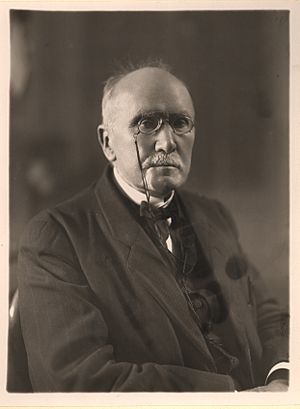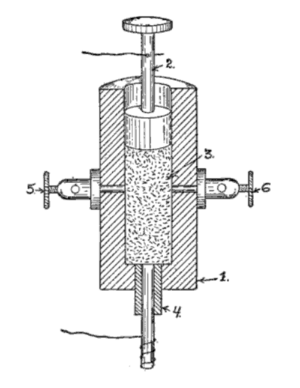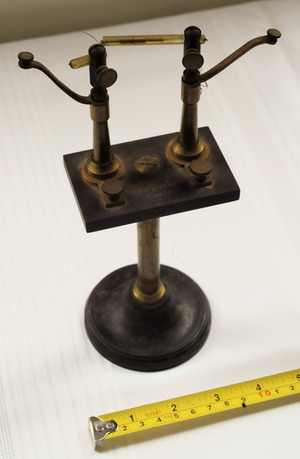Édouard Branly facts for kids
Quick facts for kids
Édouard Eugène Désiré Branly
|
|
|---|---|
 |
|
| Born | 23 November 1844 |
| Died | 24 March 1940 (aged 95) Paris
|
Édouard Eugène Désiré Branly (born October 23, 1844 – died March 24, 1940) was a French inventor and physicist. He was also a professor at the Institut Catholique de Paris. Branly is best known for his important work in early wireless telegraphy. He invented a device called the Branly coherer around 1890, which was key to receiving early radio signals.
Contents
Life Story
Édouard Branly was born on October 23, 1844, and passed away on March 24, 1940. His funeral was held at the famous Notre Dame cathedral in Paris. Even the President of France, Albert Lebrun, attended. Branly was buried in the Père Lachaise Cemetery in Paris.
The Coherer: A Radio Detector
The coherer was a very important invention for early radio. It was the first widely used detector for wireless communication. It helped turn radio waves into signals that could be understood.
How the Coherer Works
Branly's coherer was a glass tube filled with tiny iron filings (like small metal shavings). Inside the tube were two metal parts called electrodes. Normally, these filings didn't let much electricity pass through them. This is because each tiny filing had a thin layer of oxide, which is like rust, making it hard for electricity to flow.
But when a radio wave signal hit the coherer, something amazing happened! The electrical signal from the radio wave would make the filings stick together, or "cohere." This made them much better at letting electricity pass through. It was like a switch turning on.
Once the filings cohered, they would stay stuck together. To make the coherer ready for the next signal, you had to gently tap the tube. This would shake the filings apart, making them high-resistance again.
Developing the Coherer
The idea for the coherer came from earlier experiments by Temistocle Calzecchi-Onesti in 1884. Branly then developed this idea into a practical device.
In 1890, Branly showed off his "radio-conductor." Later, another scientist, Oliver Lodge, named it the "coherer." Lodge also improved it by adding a "decoherer." This was a small hammer that would tap the coherer after each signal, making it ready for the next one automatically.
The coherer was used for about ten years in radio receivers. Famous inventor Guglielmo Marconi used it in his early radio work. Around 1907, newer and better devices like crystal detectors started to replace the coherer.
Branly's Discoveries About Resistance
Branly studied how the electrical resistance of materials changed when exposed to electrical signals. He found that loose metal filings, which usually have high resistance, would suddenly become good conductors when electric waves were nearby.
He showed this by putting metal filings in a glass tube. He connected this tube to a simple electric circuit with a battery and a galvanometer (a device that measures electric current). When electric sparks were made near the circuit, the galvanometer needle would move a lot. This showed that the resistance of the filings had dropped greatly.
Branly found that this change in resistance wasn't just for a moment. Sometimes, the filings would stay in their low-resistance state for a whole day! He also noticed that tapping the tube could bring the resistance back to normal.
He discovered that:
- The circuit didn't need to be fully closed for the effect to happen.
- Even a small electric current could change the resistance.
- Using metal filings worked better than other materials he tried.
Awards and Recognition
Branly was nominated three times for a Nobel Prize, but he never won. In 1911, he was chosen to be a member of the French Academy of Sciences. He won against Marie Curie by just two votes. Both faced some opposition because Marie Curie was a woman, and Branly was a strong Catholic who had moved to a Catholic university.
When Guglielmo Marconi made the first radio communication across the English Channel, he sent a special message to Branly. Marconi said: "Mr. Marconi sends to Mr. Branly his regards over the Channel through the wireless telegraph, this nice achievement being partly the result of Mr. Branly's remarkable work." This shows how much Marconi respected Branly's discoveries.
In 2010, Branly's discovery of radioconduction was recognized as an IEEE Milestone. This is a special honor for important achievements in electrical engineering and computing.
His Legacy
A road in Paris, called the quai Branly, is named after him. This road's name then led to the naming of the famous Musée du quai Branly, a museum.
There is also a technical high school (lycée) named after Édouard Branly in Châtellerault, a town in France.
See also
 In Spanish: Édouard Branly para niños
In Spanish: Édouard Branly para niños
- Musée Édouard Branly, which preserves his laboratory
- Radio: History of radio, Invention of radio
- People: Alexander Stepanovich Popov, Karl Ferdinand Braun
- U.S. Patent 796,800 : "Receiver for use in wireless telegraphy" Edouard Branly, 1905




